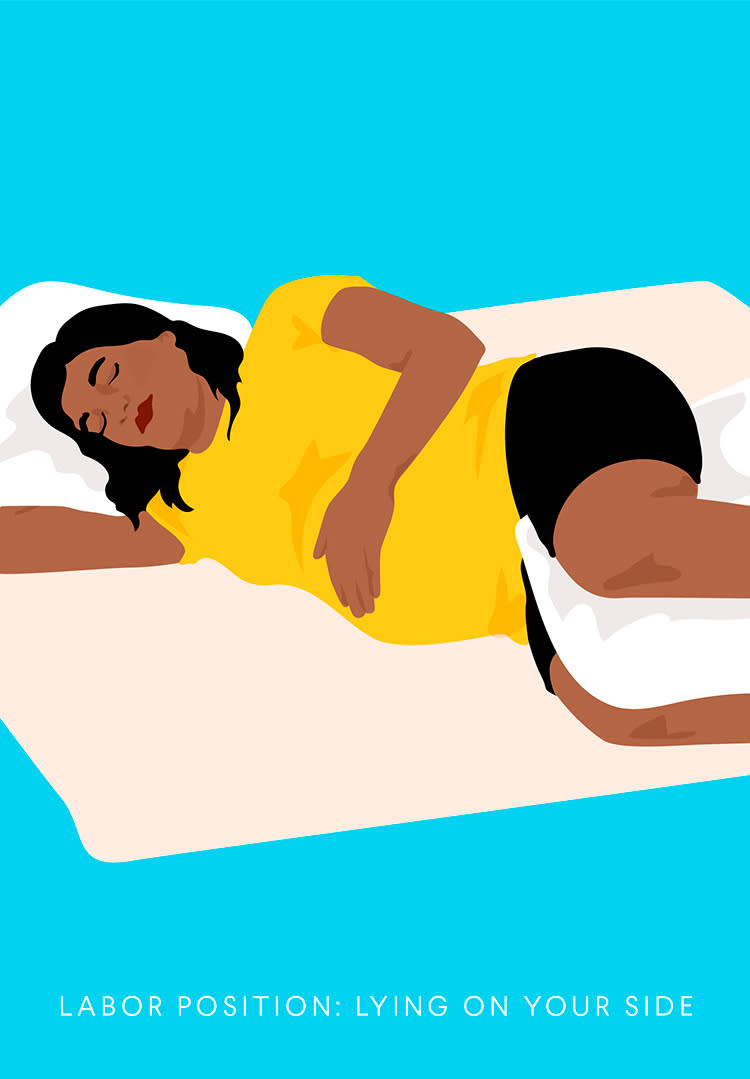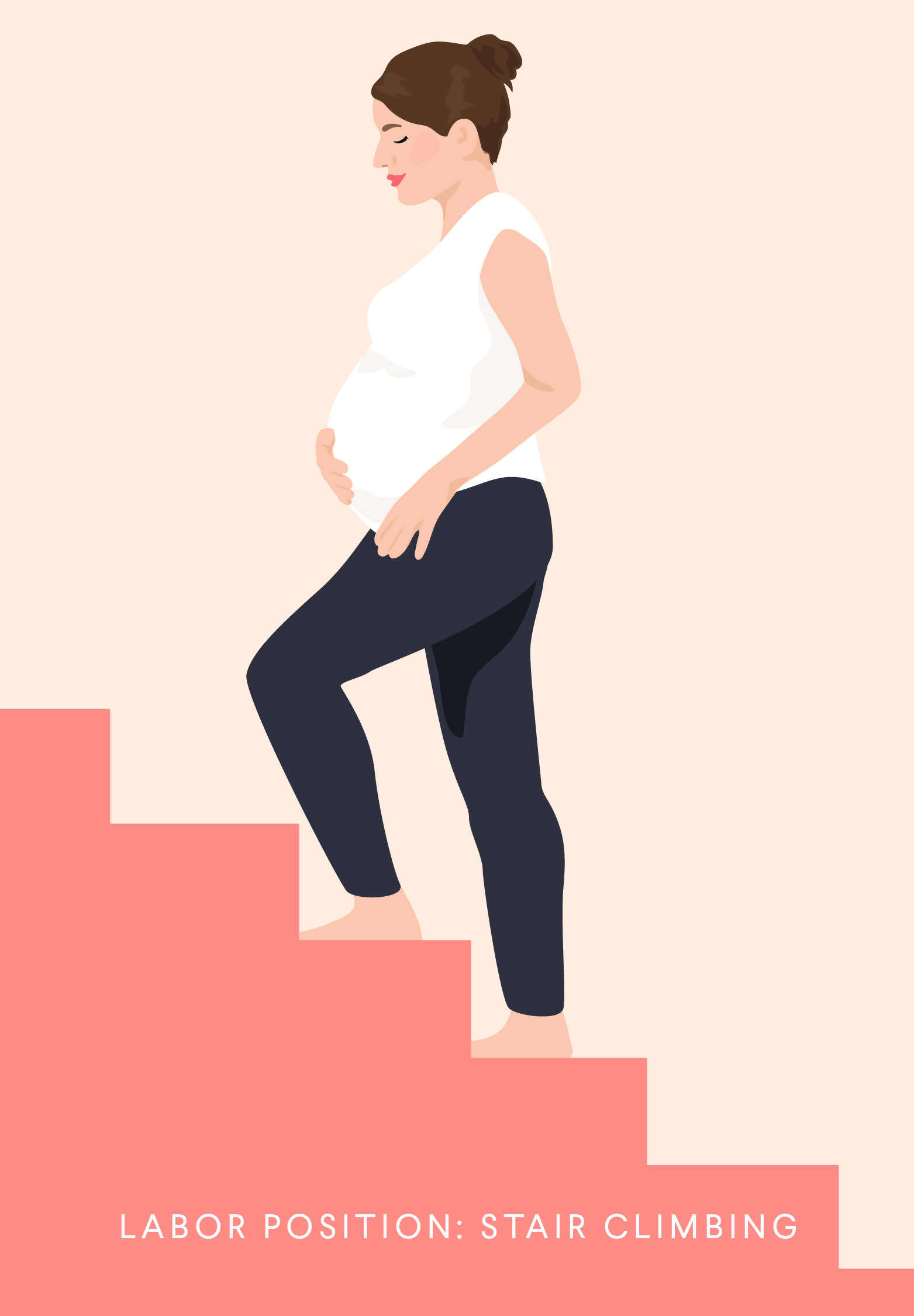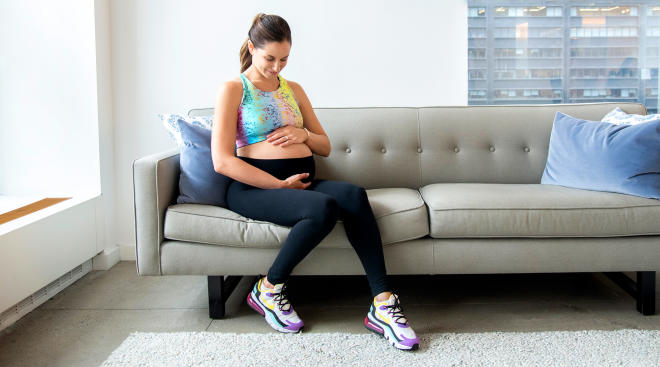The Best Labor and Birthing Positions for You and Baby
For nine months you prep and plan for baby’s arrival. You read books, watch videos and maybe even take a birthing class or two. But while movies and TV shows have led many of us to believe both labor and delivery happen while lying on your back with your legs spread wide, anyone who’s been through the experience will tell you it doesn’t have to play out that way.
There are actually a variety of labor positions you can assume during the first phases of childbirth and a whole other set that makes for good birthing positions when it’s time to push—and they don’t all call for you to be flat on your back. “Rotating between different labor and birthing positions is important to optimize conditions for the mom and baby,” says Sara Twogood, MD, an obstetrician gynecologist at Cedars Sinai Medical Center in Los Angeles and author of Ladypartsblog.com. “For Mom, this could mean making her more comfortable, especially if she’s having a medication-free birth. It can also mean maximizing the space in her pelvis so baby has more room.”
Here’s a primer on some of the best labor and birthing positions to help you prepare for the big day.
The process of giving birth takes work (it’s not called “labor” for nothing). But that doesn’t mean you shouldn’t find a way to be as comfortable as humanly possible. “Labor positions are used during the labor process to help ease discomfort, move the baby down through the pelvis and encourage optimal fetal positioning,” says Lindsey Bliss, a birth doula and co-director of Carriage House Birth in New York City. “If you end up choosing not to utilize drugs for pain management, labor positions are essential for easing discomfort.”
Active labor, the phase in which contractionscome on strong, is often when things really start to hurt. But keep in mind that women don’t start pushing until the cervix is fully dilated—for some women, this happens quickly; for others, not so much. So as your body and baby prepare for delivery, there are several labor positions your doctor or midwife may suggest to get you to the pushing point more comfortably. “Labor and delivery nurses are usually really great at helping a woman move around, even with an epidural, to find the labor positions that feel best for them,” Twogood says. “I recommend women try out a number of positions during labor. Every woman and baby is different, and what works for one woman won’t be ideal for another.”
Check out some of the most common labor positions:
The hands and knees position
The all fours position calls for you to get down onto your hands and knees, either in bed or on a floor mat. “The hands and knees position is a great one, since it helps open the pelvis,” says Rebekah Wheeler, RN, CNM, is a certified nurse-midwife in the Bay Area, California. Adds Megan Cheney, MD, MPH, medical director of the Women’s Institute at Banner University Medical Center in Phoenix, “Sometimes baby’s heart rate responds better when you’re in the hands and knees position, especially if baby isn’t in the best spot.”
Pros:
- Takes pressure off the spine, easing back pain
- May help boost baby’s oxygen level
Cons:
- Your arms may get tired
The sitting position
When you feel baby’s weight bearing down, you may just want to sit down—and that’s okay. Whether it’s in a birthing chair or even on a toilet, sitting and spreading your legs in this labor position can relieve some of the pressure on your pelvis.
Pros:
- Good for resting
- Can still be used with a fetal monitoring machine
- Sitting on a toilet relaxes the perineum, which can help reduce tearing
Cons:
- A hard toilet seat can become uncomfortable
- May not be an option if you’ve had high blood pressure during pregnancy
Birthing ball positions
Besides sitting on a birthing chair or toilet, you can also work the birthing ball into your labor positions. There are more than a few women who hail the prop as their BFF during labor and delivery. “Birthing balls provide support while you shift around,” Twogood says. “Women who want movement in their hips seem to find them helpful.” You can use a birthing ball in several ways: Some women sit or rock on it, lean against it or simply drape their upper bodies over it while kneeling. It can even be used as support while squatting. “I’m a huge fan,” Bliss says. “It’s great because women can continue bouncing and moving through the contractions even while being monitored.” Check beforehand to see if your hospital uses wireless fetal monitors; if not, you’ll be limited in how far you can move in these labor positions.
Pros:
- Can help move baby into a favorable birthing position
- Relieves back pressure
- Birthing ball labor positions can help encourage dilation and move baby deeper into the pelvis
Cons:
- Can be difficult to keep your balance
- Some birthing ball labor positions are difficult to do alone
The squatting position
Squats rarely top anyone’s list of favorite exercises, but on the day you give birth, you may want to give them a try as one of your labor positions. Squatting can be done against a wall or with the support of a chair or partner.
Pros:
- Helps open the pelvis
- Gives baby room to maneuver as they head toward the birth canal
Cons:
- May become tiring
The side-lying position
Lying on your side is one of the best labor positions to try when you need a rest. That said, just because you’re lying down doesn’t mean your body is taking a break from labor; on the contrary, it can actually help baby move into the ready position. “Side-lying and using a peanut-shaped birthing ball between the legs are wonderful tools for getting baby to descend and rotate,” Bliss says. “I encourage my clients to flip from side to side during the process to help baby come down and out.”
Pros:
- Helps get oxygen to baby
- Can be used if you have high blood pressure
- Makes it easier to relax during contractions
Cons:
- May be difficult to assess fetal heartbeat
The upright position
Gravity may not be your best friend during pregnancy, but you can make it work to your advantage during childbirth through upright labor positions. Whether you’re standing, walking or swaying, simply being vertical can get you closer to the finish line. “Walking can be helpful for women who are waiting for labor to progress,” Cheney says. Amy, a mother of two from Connecticut, found that to be the case. “I walked laps around the hospital wing to speed things up,” she says. Swaying while using another person as support is also a good way to work through labor. “Rocking your hips keeps baby moving lower and lower,” Wheeler says. (It’s also good for getting a final hug of support from your partner before the main event!) Here are some other things to consider when it comes to the upright position:
Pros:
- Relieves backaches
- Can make contractions less painful
- Encourages baby to move deeper into the birth canal
Cons:
- Not typically recommended for women with high blood pressure
- A telemetry unit is needed to continuously monitor the fetal heart rate
The lunging position
Doing lunges during labor may not sound like your idea of a good time, but lunging is one of the labor positions you may want to give a whirl. Unlike at the gym, you can put your foot up on a chair for these lunges: Simply lean your body forward onto the raised foot when you feel a contraction coming on. You can repeat it as many times as you want.
Pros:
- Helps baby rotate or descend
- Opens the pelvis, giving baby more room
Cons:
- Requires a partner to help you keep your balance
The stair-climbing position
If labor has been progressing nicely and then starts to slow down, baby might need extra encouragement to slip into the optimal position for birth. You may want to consider climbing stairs as one of your labor positions, since it can help baby shift.
Pros:
- Opens pelvis, allowing baby to drop farther and push on the cervix
- Helps baby rotate and get into a better birthing position
Cons:
- Can be tiring, especially if you’ve been in labor for a while
You’ve made it through the first stages of labor—congrats! Now it’s time to switch things up and assume birthing positions for the final stretch. “Birthing positions are used to push baby out,” Bliss says. Like labor positions, birthing positions don’t always equal lying on your back. In fact, “women who are in bed tend to experience more pain than women who move around,” Wheeler says. Here are some of the best birthing positions to try.
Squatting birth positions
Squats aren’t only great to do during labor, but they’re also among the popular birthing positions. Remember, when it comes to labor and delivery, gravity is on your side.
Pros:
- Decreases the need for certain delivery tools, like forceps or a vacuum
- Helps with dilation
Cons:
- Baby’s position may not be right for squatting
- Can lead to more tearing if done without a birthing stool or other aid
Reclining birth positions
Childbirth is hard work, and you might need to take a break—which is why many women opt for reclining birthing positions. Keep in mind, “reclining” can mean a number of things—yes, you can lie down in bed, but you can also recline against a wall, a chair or another person.
Pros:
- Can release tension and relax the muscles
- May be a good alternative if a woman is tired but doesn’t want to lie down completely
Cons:
- Can work against gravity
Birthing stool positions
A birthing stool can be used in a variety of birthing positions: Women can squat on it, get in the all fours position and use it to support the arms or even rock back and forth with it, depending on the design of the stool. Bonus: If you like the idea of a water birth, there are some birthing stool models that work in the water.
Pros:
- Can help baby move farther down
- Relieves stress on the back
- Can increase dilation of the cervix
Cons:
- Women may experience increased blood loss
Birthing bar positions
Call it the birthing stool’s cousin: The birthing bar is an attachment that can be added to many labor beds to help support birthing positions. With a birthing bar, you can sit up at any time and squat, leaning on the bar for support. “The birthing bar can be an awesome tool. You can wrap a towel on it to make it easier to use and switch positions,” Wheeler says. That proved to be true for Jennifer, a mom of two from Connecticut, who recalls that “after about two hours of pushing with no success, the birthing bar was put on the bed. It helped me get the resistance I needed to push to the point where the doctor could intervene.”
Pros:
- Expands the pelvis
- Uses gravity to push baby down
Cons:
- May not be available at all hospitals
Kneeling birth positions
If baby is facing Mom’s abdomen instead of her back, kneeling can help them turn to get into the proper position. Kneeling is one of the most popular birthing positions because it also gives mom a much-needed break.
Pros:
- Relieves pain of contractions
- Eases back pressure
Cons:
- May be difficult for continuous fetal monitoring
When it comes to labor and birthing positions, discuss all options with your doctor or midwife to land on the ones that will be most comfortable and practical for you. “Every baby and mom responds to positions differently. It’s the job of the labor assistant to help figure out what works best,” Wheeler says. Whichever labor and birthing positions you choose, it’ll all be worth it when baby is finally placed in your arms.
Expert bios:
Sara Twogood, MD, FACOG, is a board certified obstetrician-gynecologist at Cedars Sinai Medical Center in Los Angeles. Previously, she held a faculty appointment at USC Keck School of Medicine and practiced general OBGYN in an affiliated private practice. Twogood is also the author of Ladypartsblog.com, which covers topics relating to fertility and pregnancy, and the founder of FemEd, a program designed to empower females through health education.
Lindsey Bliss is a birth doula and co-founder of Carriage House Birth, a doula agency established in New York City in 2012 that now serves Los Angeles as well.
Rebekah Wheeler, RN, CNM, MPH, is a certified nurse-midwife in the Bay Area, California. She is the founder of the Malawi Women’s Health Collective, a small non-profit organization, and has served on the boards of the California Nurse-Midwifery Association, Planned Parenthood of Rhode Island and the Women’s Health and Education Fund of Southeastern Massachusetts. She holds a Master’s of Public Health and a Master’s of Science in Nursing from Yale University.
Megan Cheney, MD, MPH, is an ob-gyn and the medical director of the Women’s Institute at Banner University Medical Center in Phoenix, Arizona. She earned her medical degree from University of Arizona College of Medicine in 2009.
Please note: The Bump and the materials and information it contains are not intended to, and do not constitute, medical or other health advice or diagnosis and should not be used as such. You should always consult with a qualified physician or health professional about your specific circumstances.
Plus, more from The Bump:
Navigate forward to interact with the calendar and select a date. Press the question mark key to get the keyboard shortcuts for changing dates.

































































